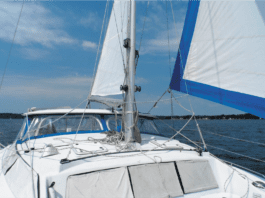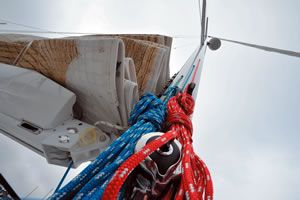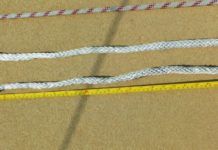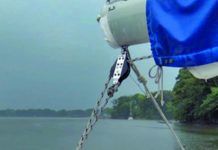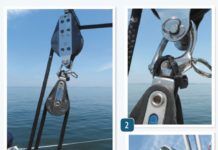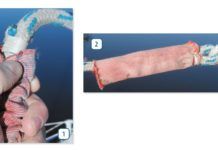Adding a Polyester Cover to Dyneema Single Braid
Extremely low friction allows Amsteel and other high molecular weight polyethylene (HMPE) lines to run like lightening through low friction rings. Unfortunately, they also run right through cleats, jammers, and your hands. If a jammer did hold-and it wont-the load would probably exceed the capacity of any device that matched the lines tiny size.
Splice Failure Linked to Fatality
On the 4th of September 2015, Andrew Ashman was killed during an accidental jibe, when the boom delivered a fatal injury to the base of his neck. The boat, CV21 Ichor Coal, had been running in strong conditions, and yawing allowed the wind to get on the wrong side of the mainsail, as occasionally happens. A preventer was rigged, but a strop securing a low friction ring turning block near the bow failed, allowing the boom to cross the cockpit unrestrained. On such highly engineered boats, how did this happen?
A Sure Way to Secure the Boom
When the wind really blows, the pleasant chiming of a marina takes on a different character. Above the howling of the wind is the Devils Tattoo, the racket of one hundred poorly-secured halyards hammering against aluminum. Booms creak from side-to-side, and some pound against stays. Workers are distracted and anyone living aboard wishes his neighbors had taken a few small steps to preserve the peace, not to mention their rig.
Penny Pincher Pawl Lube
Winch pawls require a different lube the rest of the winch. The only time they are moving is under practically no load, clicking along the ratchet wheel until the handle stops turning. A heavy packing of grease can stick and prevent full engagement, resulting in broken pawls, gouged ratchet wheels, and in the worse case, crew injury when the handle spins backwards.
Undoing Mainsheet Twist
What kind of line do you use in your davit tackle? My lines keep twisting, chafing, and jamming. The ropes run crooked in the blocks no matter how often I restring them, asks Sailor One.
Winches Part 2
In our second look at sailboat winches, we put the deck hardware into action, sea trialing traditional winches that have stood the test of time as well as the newest trends in winch design. Our goal was to hone in on the operational aspects of each winch, scrutinizing how each drum handled line loads and noting which drum shapes were less prone to overrides. Testers also compared the effectiveness of self-tailing systems and the various drum surface finishes used to keep the line from slipping.
Winches: Ratios and Reality
When comparing winches, its important to understand how input and output interface. The winch handle is a rotary lever that is the first stage of power amplification. The ratio of drum radius-to-handle length is the first force multiplier. An 8-inch handle and a 2-inch radius drum, therefore, deliver a 4-to-1 boost in pulling power and a 4-to-1 decrease in line-hauling speed.
Sewn Splices Two-Year Followup
The true test of marine gear is not whether it works when installed, but rather how it functions after years in the field. To that end, we have left samples of sewing materials and sewn test samples in the sun, wind, rain, and snow for two years, and have also sailed with sewn samples in service on our test boat.
The No-sew Webbing Strap with Link Buckle
Weve sewn our fair share of eyes in nylon webbing, but heres an easy no-sew alternative for creating a webbing strap with a buckle (shackle) that can be used for easily lashing down the dinghy, a battery, or even holding up your pants in a pinch. It is based on stuff a sailor has on hand-webbing, a chain link, and a shackle-and is as strong as professionally sewn ends, plus it can be untied after loading. It has tested at greater than 85-percent breaking strength and 100 percent of minimum rate strength, and it works on both nylon and ultra-high strength materials like Vectran webbing.
Fitting a Roller Furling Line
Replacing the roller-furling control line is an easy do-it-yourself job for the boat owner. Inexpensive, double-braid Dacron is a fine choice for furling lines on most boats shorter than 40 feet. On longer boats, you can opt for a furling-line material of more esoteric double-braids with less stretch. However, any line smaller than 3/8-inch diameter is too difficult to grip.


































